"Steve Austin. Astronaut. A man barely alive.
Gentlemen, we can rebuild him.
We have the technology.
We have the capability to make the world's first bionic man.
Steve Austin will be that man.
Better than he was before.
Better. Stronger. Faster."
-Oscar Goldman narrating the opening theme-


"I've got a blow-out in damper three. Pitch is out! I can't hold altitude! Flight Com! I can't hold it. She's breaking up, she's break..."
-Steve Austin-

"What binds me... is my love for heroes, which I think comes from being a child of World War II, when heroes on the screen, in the field and in the White House were gigantic. The American hero was preeminent, and I've not lost that idealism. So for me, Steve Austin was a unique kind of hero, with a marvelous twist of science fiction. But he was first and foremost a human being."
-Harve Bennett on his vision of Steve Austin (The Bionic Book, p.31.)-

My, how far America has fallen for some since these lofty ideals. I cringe when I think of these ideals and how they are not embodied by our political leaders today in any way shape or form. Threads of rampant anti-exceptionalism espoused by the likes of President Obama in speeches abroad and to Americans has indeed been the running theme. The language and lack of inspiration is indeed troubling. It's actually fashionable to knock America.

I consider the leadership of Harry S. Truman, John F. Kennedy and Ronald Reagan as real benchmarks in leading this country to an inspired future of greatness. Where have all the statesmen gone? Well, once upon a time excellence meant something very different than it does today.
So with interest in Glen A. Larson's efforts to create the American equivalent of James Bond fading, as noted in the three pilot films covered here at Musings Of A Sci-Fi Fanatic, the move was to create a TV series for Steve Austin as the Bionic Man or as the remarkable Six Million Dollar Man.

Producer Harve Bennett was brought into the fold for The Six Million Dollar Man (1974-1978). The series represented the more traditional hero rarely experienced in television today. In fact, even The Six Million Dollar Man seemed to cut against the grain of a downbeat decade. Steve Austin was a technological inspiration to the decay of the 1970s. This was a hero free of irony or a dark side. This was a child's hero pure and simple. His words and actions were his bond, but not James Bond.

Bennett is perhaps best remembered as the man who would salvage the commercial disappointment of the resurrected Star Trek in its motion picture form following Star Trek: The Motion Picture (1979). Thus Bennett, known to have found the first Star Trek film "boring" was hired by Paramount to right the ship. Bennett would plant the space seeds for Star Trek II: The Wrath Of Khan (1982). So with a story, a sense of fun and mission executive producer Bennett, with his guidance, landed the Star Trek franchise arguably its mightiest film in cinema history.

Bennett also served as a producer and writer on the next three Star Trek films: Star Trek III: The Search For Spock (1984), Star Trek IV: The Voyage Home (1986) and Star Trek V: The Final Frontier (1989).
Bennett's reputation for turning a property around wasn't unheard of. He had earned himself something of a reputation in that field. Following Larson's departure (on the second and third pilot telefilms only) and following the first three The Six Million Dollar Man telefilms, Bennett was brought on board for The Six Million Dollar Man TV series to develop it following his success on the classic The Mod Squad (1968-1973; three of the five years) as a writer and developer for Aaron Spelling.

Bennett believed, "You cannot take Lee Majors and put him into tuxedo shirts. It just doesn't work. Lee is Gary Cooper, the good ol' American Cowboy. He's [like] James Dean and Paul Newman, The American Myth No. 16. Lee Majors is not James Bond" (The Bionic Book, p.30).
Bennett continued, "We returned Lee to that monosyllabic, shy-with-the-ladies, aw-shucks kind of hero. That, to me, is what made it work. He was a modest, kind of Western man amidst all of this technology, which he used well. ... I admire military people who keep their cool when worlds collide around them. Lee portrayed that wonderfully."

Original concept writer Martin Caidin noted Bennett brought the series "back down to Earth, into the realm of believability." The rest is history as they say as The Six Million Dollar Man would become a huge television success. Much mimicking by kids quickly ensued along with action figures and toys aplenty.
What I remember most was how captivated I was by that opening theme. The edited footage of the Pilot spliced together in such a way that we were incredibly empathetic toward Steve Austin from the moment each episode started. Here was a good man involved in a terrifyingly horrific plane crash, based on a true event, and near death he is reassembled through technology for a second chance. How could we not get behind that? Austin was especially charming, handsome and a survivor. As a child those images of his crash were indelibly burned to memory. It didn't hurt that my mother purchased a hand cranking movie player with a cartridge of the show for me to relive the horrors of his crash followed by his rebirth. The creative team made a stunning impact on me.

We offer the first of two parts, a snapshot, focused on Season One which grounded the popular character and the brief observations of the series first seven episodes. The series has generally not aged well and was certainly not targeting the more mindful, mature viewer. Anyone exposed to television of the caliber found available today will note its deficiencies far and wide.
But for those looking to check out and perhaps turn back the clock for a bit of nostalgia, The Six Million Dollar Man is worth your time. It will be interesting to note where the series genuinely gets it right across its five season run--- a very fast run in the hands of Lee Majors.

At the conclusion of the series run in 1978, the influence of those powerful slow-motion bionic effects were felt almost immediately when the regular run of The Incredible Hulk (1977-1982) was launched as a TV series (1978) that same year. The powerful, unstoppable Lou Ferrigno embodied the massive beast in all of his slow-motion glory carrying the torch of 1970s hero icon Steve Austin, The Six Million Dollar Man.

The Six Million Dollar Man, Season One began with Episode 1, Population Zero. The illustrious executive producer Harve Bennett took over the reins of The Six Million Dollar Man and launched with Population Zero in January 1974.
The debut of the series features a rogue government scientist hell bent on revenge. He demands money---just ten million. How about four million and Steve Austin? Austin is sent by Oscar Goldman to save a population from a lethal device.
Lee Majors continues to develop a cheekier sense of humor whilst his relationship warms with Goldman becoming more and more palatable from the cooler connection made during the pilot telefilms.

Speaking of cool, Population Zero glimpses one of the great weaknesses to Austin in that the Bionic Man's bionics can be affected by the cold.
Slow motion action rounds out the relatively exciting climax as technology goes head to head with technology and good versus evil. And Steve Austin clearly gets to bed his latest babe. James T. Kirk eat your heart out.
There is one emotionally resonant moment where Austin becomes irritated by a doctor's question of his new physical state underscoring the psychology of a man still coming to terms with his new powers and physical transformation all while working to save the world. It's that deeper emotional connective tissue and subtext that makes Steve Austin such a relatable character and gave the series its longevity. Truth be told there is not a great depth of it in Season One as the series thankfully falls back on the charms of the irresistible Lee Majors. Average. Writer: Elroy Schwartz (brother to Sherwood Brady Bunch Schwartz). Director: Jeannot Szwarc (Jaws II, Supergirl, Fringe, Heroes).

Episode 2, Survival Of The Fittest sees Austin and Goldman survive a plane crash with others Lost-styled in the Pacific. A hit is intended for Goldman in order to prevent ongoing negotiations with the Russians. See Steve Austin change a tire in seconds flat. No jack or crowbar required. See Steve leap off a cliff following an airplane crash. See Steve break a coconut in half for sustenance. Austin must protect Goldman from the hit. The real highlight is the classic slo-mo effect of Steve Austin rescuing Oscar from a deadly snake utilizing his great strength, speed and bionic eye. What is still missing is the trademark sound effect that accompanies the slo-motion. Witnessing Austin propel a rock to disable the villain without that classic bionic sound simply loses its impact.

In the end, Austin must cut his fingers to implement two wires from his very body to save Goldman by cauterizing his wound. What's telling is that the sequence speaks to Austin's character. When Goldman regains consciousness Austin never tells Goldman why his finger was cut even though he saved his life. This sows the seeds to a longstanding friendship as the two move closer going forward. Unfortunately a money grab has been a component of villain motivations in these first two entries of the regular season, but that was relatively common in the 1970s. Future Battlestar Galactica (1978-1979) alum, the gorgeous Laurette Spang (a.k.a. Cassiopea), guest stars.
This entry was re-worked for The Bionic Woman, Season One, Episode 11, Fly Jamie.

Episode 3, Operation Firefly begins as scientist Dr. Samuel Abbott, creator of a laser projector, goes missing. Steve Austin is sent by Oscar Goldman to Spain to locate his daughter. Gifted with ESP she may be able to help find her father.
We discover Steve Austin has a gift for the guitar and even uses his bionic speed to impress the locals and gets her attention.
Other incredible feats include Austin using his right leg and bringing a speeding taxi to a halt following an effort to see Abbott's daughter killed while in Austin's care. Nice detailed touches include smoke off his boot.
He also hand carves a small boat out of a fallen log, bends prison bars and knocks around thugs with a tree---the kind made popular on that lunchbox from the 1970s. Steve Austin and David Banner always had to deal with the henchman. The villains always had plenty of henchmen. The Bionic Woman and Wonder Woman had their problems too.

But in one of those unfortunate and fairly comical 1970s moments, Austin tackles a rubber alligator---also on that lunchbox. There is no editing in the world than can help Austin in that moment and thus not an ounce of realism. It rivals the stuffed bear thrown by The Hulk in The Incredible Hulk's Death In The Family (here). It's a positively laugh out loud moment. Ironically, the episode also has the trademark quick sand moment also seen in the aforementioned Hulk episode. Were these guys sharing the same set?
It's always amusing to see Austin chained up only so we can watch him break free of those chains.
Sadly, an arms dealer attempts a ten million dollar money grab from Oscar Goldman with the episode presenting the crime of extortion for the third time in a row. And of course, in American Bond style, Austin always gets his girl.
And still no sign of the classic bionic sound effect. Though we do hear the trademark cross-hair bionic eye sound effect here for the first time. This is also the first official mention of OSI as the Office of Scientific Intelligence.

Episode 4, Day Of The Robot: "Oscar, is there anyone else like me?" -Steve Austin-
The fourth entry is the most natural in terms of character and dialogue exchange as cyborg Steve Austin is pitted against a robot in the form of an old friend, Major Fred Sloan, played by John Saxon. The character exchanges give the episode a brisker pace.
There is a terribly awkward moment where the robot crashes their car going 80mph, but both Austin and the robot are entirely unharmed as is the car when it crashes into a ditch. It's a little hard to swallow, but alas the standards for the 1970s allowed for a fairly long rope or berth concerning room to maneuver a story while defying physics.

Saxon is fairly effective playing himself with a slightly rigid or robotic edge. Austin is suspicious. The robot does blow its cover when it aids Austin in lifting their car from the ditch, but Austin plays it smooth.
It becomes even more intriguing as Austin attempts to throw questions at Sloan. In a fascinating turn, Austin cleverly mentions an event to Sloan he mentioned earlier and does it a third time discovering Sloan responds with the exact same answer.
It's game on and robot Saxon proves a formidable foe.

Day Of The Robot exploits the theme of cyborg technology and the dawning of pure robotics. All of it is pursued by both the forces of good and evil. Unfortunately, these great ideas are hamstrung by those 1970s television aspirations to appeal to the young. But beyond that, television simply hadn't matured or pushed the boundaries of complexity and thus The Six Million Dollar Man performs its mighty best with these ideas within the confines of an era.
Despite an entertaining battle royale between Austin and Sloan, for me, it really loses much of its impact without that bionic sound effect. But alas, this is the first episode that we hear it. It's used 4-5 times and merely to heighten the effect of the attacking robot Sloan and not Austin. The series continues to find ways to improve.
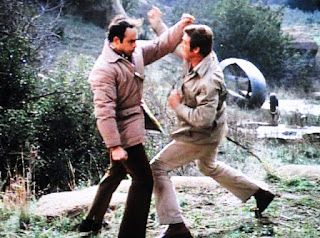
Some of the editing is a little odd beyond the nifty slow motion effects. The sound employs the use of strange, guttural animal sounds the equivalent of snarls along with some other weird sound effects. It is totally bizarre. Sloan isn't The Hulk. What is going on here? But the creators do their best to generate a dramatic epic battle between cyborg and robot titans.
A rather affecting, poignant moment concludes the episode along with a nice ending for the kiddies as Sloan is found brainwashed and simply wandering. Austin is relieved to reunite with his lost friend. Not to overthink this it was a fun entry back in the day.

Saxon would later return for The Six Million Dollar Man and The Bionic Woman.
Actor Marc Alaimo also guests in a small role. Alaimo would become a critical component as villain Gul Dukat in the tremendous Star Trek: Deep Space Nine (1993-1999). He also appeared regularly in Star Trek: The Next Generation including the Season One episode, The Neutral Zone as Tebok. The actor has appeared in genre favorites like this one, The Bionic Woman, The Incredible Hulk, and The Greatest American Hero.

Episode 5, Little Orphan Airplane makes it clear at this point that the writers were establishing Steve Austin as a genuine American hero with less Bond-like suave and more John Wayne like swagger. He was directly connected to the American military as a special weapon of the OSI (Office of Scientific Intelligence).
Austin must go behind enemy lines in Africa as a solo agent to retrieve a missing pilot and top secret information.

Parachuting into his mission following a rather Bond-like action sequence, Austin manages a humorous exchange with two Hollywood-obsessed nuns speaking a foreign tongue. There are even subtitles here. In a clever twist one of the nuns is the head of the Dale Robertson fan club and has seen every episode of the Tale Of Wells Fargo (1957-1962; 200 episodes). Robertson passed away in February of 2013. While it often defies logic or even sometimes crosses the line of credibility Little Orphan Airplane may be the most entertaining entry of Season One to this point. It's especially fun to watch Majors growing more comfortable with each passing entry. Behold as Steve Austin MacGyver's his way to success. While each of these episodes is indeed padded with excessive filler shots commonplace in the 1970s there is something nostalgic about the approach versus today's tight, engaging, compelling, expeditiously paced stories that leave nothing to waste. And Bionic sound effects are dropped once again.
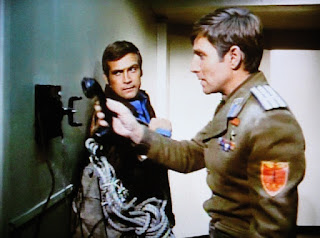
Episode 6, Doomsday, And Counting sees The Six Million Dollar Man continue to tap not only the technological nerve that was proliferating in the 1970s, but also fears surrounding the Cold War (1947-1991) and our relationship with the, then, Union Of Soviet Socialist Republics (USSR) and now more specifically Russia.
The hardest thing to get around for me personally was seeing American actor Gary Collins play the role of Colonel Vasily Zhukov. No effort is made to differentiate the Russians from the Americans apart from a uniform. Collins sounds like he just got off the beach in California, which is actually where he is from unless he was living on United States soil like a spy from The Americans (2013-present). In fact, in a rather funny moment, Oscar Goldman greets the Russian commander with Russian and Goldman is the only one who speaks a word of it the entire episode. The American did better than the alleged Russians.

While the episode lacks believability as a result of ineffective casting and lacks a typically over simplistic story, The Six Million Dollar Man does a remarkably good job of creating a sense of place and scale. Steve Austin's adventures feel real and as children the creators really sold these grand adventures. In this case Austin must infiltrate a crippled nuclear facility and help rescue others and escape before the facility blows. Austin saves the day with a remarkable two seconds to spare. Still no proper bionic sound effects.

Episode 7, Eyewitness To Murder guests the one and only Gary Lockwood (Star Trek: The Original Series, Starsky & Hutch) guests as an assassin called John Hopper a.k.a. The Big Buy. Austin gives new meaning to the eye in eyewitness and with that bionic eye and more assured effects and sound for the maneuver Austin doesn't miss much.
It's amusing to see Oscar Goldman speak of the classified nature of The Six Million Dollar Man yet openly speaks to Austin about his physical make-up as he walks by citizens.
One scene speaks to the heart of the growing respect between Austin and Goldman. Oscar tells Steve he could order him not to follow Hopper. Austin says, "I know pal, I'll be in touch," and off he goes anyway. There is indeed a genuine trust building between these two professionals. That was always a hallmark of the series along with Austin's trademark and knowing wink or sly humor.

What amazes me is how far we've come with television. The padding and filler of these once long-running series is no longer an issue. Artistic license to tell a story is no longer hamstrung by censors and filler nonsense. The boundaries have been pushed to the point that almost anything is possible within television as an artistic and storytelling medium. Many of these factors certainly harmed programs like The Six Million Dollar Man once upon a time.
Keeping the program in perspective and relative to its era, this series has many charms if not always entertaining. It's astounding how on very simple terms with minimal effects work The Six Million Dollar Man created the illusion of a man with super strength that captured the imagination of millions of children everywhere.

Despite our desire for excellence or at least the belief in that by some as a people in the 1970s, these early episodes are quite to the contrary, rough and strictly for the super fans. Watching something like this today, particularly to the unexposed (or the overexposed) could prove painful to them and you. This writer must confess you need to be in a very special place and within the right frame of mind to truly tackle such classic material. Those moments are few and far between.











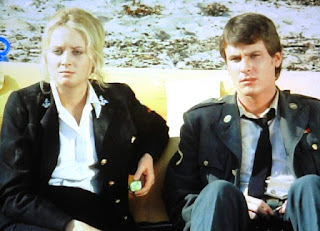





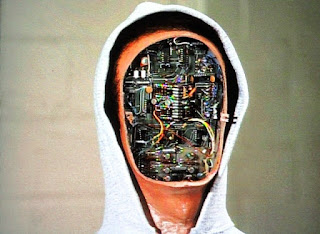
















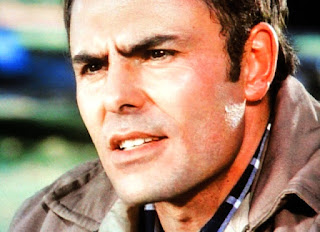





























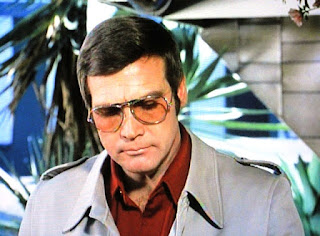

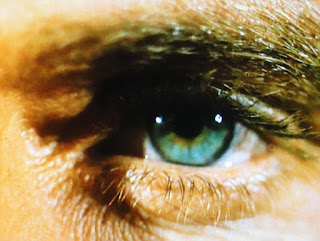











4 comments:
"Despite our desire for excellence or at least the belief in that by some as a people in the 1970s, these early episodes are quite to the contrary, rough and strictly for the super fans. Watching something like this today, particularly to the unexposed (or the overexposed) could prove painful to them and you. This writer must confess you need to be in a very special place and within the right frame of mind to truly tackle such classic material. Those moments are few and far between."
Well said! I would say that much like THE BIONIC WOMAN, the enjoyment of this show relies largely on the charms and charisma of its leading actor. Lee Majors carries the show and you care about what happens to him. Same goes for Lindsay Wagner. Of course, I'm biased as I watched both shows back in the day so I have a certain amount of nostalgic memories tied to both shows.
It's definitely nostalgia pie for me most of the time.
Cheers JD! hope all is well.
I am a big Lee Majors fan and yes sometimes it is difficult to go back to watch some of the old shows but he makes enjoyable to me. Great site here
Thank you very much Linda. I try to make Musings Of A Sci-Fi Fanatic a place I would want to visit if I was a fan of these particular programs and the genre.
Lee Majors is terrific! Despite its deficiencies today, Lee Majors is worth the price of admission. Personally I agree.
Post a Comment